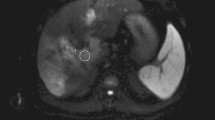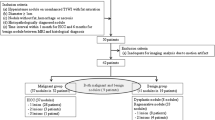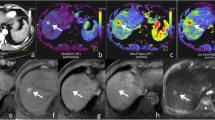Abstract
The purpose of this study was to compare between superparamagnetic iron oxide (SPIO)-enhanced three-dimensional balanced turbo field-echo (B-TFE) sequence with T2 preparation pulse (T2 prep) and T2*-weighted imaging (T2*WI) for the simultaneous detection of hepatocellular carcinoma (HCC) and vessel thrombus. For 1.5-T magnetic resonance imaging, SPIO was administered to 23 patients with a portal or venous tumor thrombus, and B-TFE with T2 prep and T2*WI were acquired. Regions of interest in the B-TFE and T2*WI were selected for the tumor, liver, tumor thrombus, and vessels. The contrasts of the HCC in the liver and the tumor thrombus in the vessels were determined from clinical image. Contrast was calculated using the mean value of the signal intensity on the HCC to the liver and tumor thrombus to vessels. The mean contrasts between HCC and the liver with the use of B-TFE and T2*WI were 0.61 ± 0.05 and 0.70 ± 0.04, respectively. The contrast of HCC to the liver was significantly higher in T2*WI than in B-TFE (p < 0.05). The mean contrasts between the tumor thrombus and vessels with the use of B-TFE and T2*WI were 0.28 ± 0.02 and 0.10 ± 0.02, respectively. The contrast of tumor thrombus in the vessels was higher in B-TFE than in T2*WI (p < 0.01). Kupffer imaging can be used to assess liver function and acquire morphological images using three-dimensional B-TFE with T2 prep. This technique would be helpful for simultaneous detection of HCC and tumor thrombus.




Similar content being viewed by others
References
Kew MC. Epidemiology of hepatocellular carcinoma. Toxicology. 2002;181–182:35–8.
Ribeiro A, Nagorney DM, Gores GJ. Localized hepatocellular carcinoma: therapeutic options. Curr Gastroenterol Rep. 2000;2:72–81.
Yamashita T, Kaneko S. Treatment strategies for hepatocellular carcinoma in Japan. Hepatol Res. 2013;43:44–50.
Yang B, Zan RY, Wang SY, Li XL, Wei ML, Guo WH, et al. Radiofrequency ablation versus percutaneous ethanol injection for hepatocellular carcinoma: a meta-analysis of randomized controlled trials. World J Surg Oncol. 2015;13:96.
Eisele RM, Schumacher G, Neuhaus P. Local recurrence following hepatic radiofrequency ablation. Diagnosis and treatment. Strahlenther Onkol. 2008;184:598–604.
Su TS, Liang P, Lu HZ, Liang J, Gao YC, Zhou Y, et al. Stereotactic body radiation therapy for small primary or recurrent hepatocellular carcinoma in 132 Chinese patients. J Surg Oncol. 2016;113(2):181–7.
Llovet JM, Bustamante J, Castells A, Vilana R, Ayuso Mdel C, Sala M, et al. Natural history of untreated nonsurgical hepatocellular carcinoma: rationale for design and evaluation of therapeutic trials. Hepatology. 1999;29(1):62–7.
Lee HS, Kin JS, Choi IJ, Chung JW, Park JH, Kim CY. The safety and efficacy of transcatheter arterial chemoembolization in the treatment of patients with hepatocellular carcinoma and main portal vein obstruction. A prospective controlled study. Cancer. 1997;79:2087–94.
Sugahara S, Nakayama H, Fukuda K, Mizumoto M, Tokita M, Abei M, et al. Proton-beam therapy for hepatocellular carcinoma associated with portal vein tumor thrombosis. Strahlenther Onkol. 2009;185:782–8.
Kogita S, Imai Y, Okada M, Kim T, Onishi H, Takamura M, et al. Gd-EOB-DTPA-enhanced magnetic resonance images of hepatocellular carcinoma: correlation with histological grading and portal blood flow. Eur Radiol. 2010;20:2405–13.
Vogl TJ, Kümmel S, Hammerstingl R, Schellenbeck M, Schumacher G, Balzer T, et al. Liver tumors: comparison of MR imaging with Gd-EOB-DTPA and Gd-DTPA. Radiology. 1996;200:59–67.
Collidge TA, Thomson PC, Mark PB, Traynor JP, Jardine AG, Morris ST, et al. Gadolinium-enhanced MR imaging and nephrogenic systemic fibrosis: retrospective study of a renal replacement therapy cohort. Radiology. 2007;245:168–75.
Nishie A, Tajima T, Ishigami K, Ushijima Y, Okamoto D, Hirakawa M, et al. Detection of hepatocellular carcinoma (HCC) using super paramagnetic iron oxide (SPIO)-enhanced MRI: added value of diffusion-weighted imaging (DWI). J Magn Reson Imaging. 2010;31:373–82.
Catalano OA, Choy G, Zhu A, Hahn PF, Sahani DV. Differentiation of malignant thrombus from bland thrombus of the portal vein in patients with hepatocellular carcinoma: application of diffusion-weighted MR imaging. Radiology. 2010;254:154–62.
Le Bihan D, Poupon C, Amadon A, Lethimonnier F. Artifacts and pitfalls in diffusion MRI. J Magn Reson Imaging. 2006;24:478–88.
Kanematsu M, Itoh K, Matsuo M, Maetani Y, Ametani F, Kondo H, Kato H, Hoshi H. Malignant hepatic tumor detection with ferumoxides-enhanced MR imaging with a (1.5-T system): comparison of four imaging pulse sequences. J Magn Reson Imaging. 2001;13:249–57.
Scheffler K, Lehnhardt S. Principles and applications of balanced SSFP techniques. Eur Radiol. 2003;13:2409–18.
Smith CS, Sheehy N, McEniff N, Keogan MT. Magnetic resonance portal venography: use of fast-acquisition true FISP imaging in the detection of portal vein thrombosis. Clin Radiol. 2007;62:1180–8.
Lee CU, Glockner JF. Vascular staging of renal and adrenal malignancies with a noncontrast enhanced steady state free precession technique. J Magn Reson Imaging. 2011;33:1406–13.
Enden T, Storås TH, Negård A, Haig Y, Sandvik L, Gjesdal KI, et al. Visualization of deep veins and detection of deep vein thrombosis (DVT) with balanced turbo field echo (b-TFE) and contrast-enhanced T1 fast field echo (CE-FFE) using a blood pool agent (BPA). J Magn Reson Imaging. 2010;31:416–24.
Brittain JH, Hu BS, Wright GA, Meyer CH, Macovski A, Nishimura DG. Coronary angiography with magnetization-prepared T2 contrast. Magn Reson Med. 1995;33:689–96.
Kanamoto M, Miyati T, Terashima K, et al. Preliminary study of detection of hepatocellular carcinoma (HCC) and vessel thrombosis using superparamagnetic iron oxide (SPIO)-enhanced balanced turbo field echo (B-TFE) with T2 prep. Med Imag Infor Sci. 2014;31:19–23.
Oswald P, Clement O, Chambon C, Schouman-Claeys E, Frija G. Liver positive enhancement after injection of superparamagnetic nanoparticles: respective role of circulating and uptaken particles. Magn Reson Imaging. 1997;15:1025–31.
Namkung S, Zech CJ, Helmberger T, Reiser MF, Schoenberg SO. Superparamagnetic iron oxide (SPIO)-enhanced liver MRI with ferucarbotran: efficacy for characterization of focal liver lesions. J Magn Reson Imaging. 2007;25:755–65.
Reimer P, Tombach B. Hepatic MRI with SPIO: detection and characterization of focal liver lesions. Eur Radiol. 1998;8:1198–204.
Frydrychowicz A, Lubner MG, Brown JJ, Merkle EM, Nagle SK, Rofsky NM. Hepatobiliary MR imaging with gadolinium-based contrast agents. J Magn Reson Imaging. 2012;35:492–511.
Li C, Hu J, Zhou D, Zhao J, Ma K, Yin X, et al. Differentiation of bland from neoplastic thrombus of the portal vein in patients with hepatocellular carcinoma: application of susceptibility-weighted MR imaging. BMC Cancer. 2014;14:590.
Okada M, Imai Y, Kim T, Kogita S, Takamura M, Kumano S, et al. Comparison of enhancement patterns of histologically confirmed hepatocellular carcinoma between gadoxetate-and fercarbotran-enhanced magnetic resonance imaging. J Magn Reson Imaging. 2010;32:903–13.
Acknowledgements
The authors would like to thank the Prof. Kunio Doi for great helpful discussions and support. The authors would like to thank Yusuke Tsunei and Yuki Yamamoto at the Department of Radiation Technology, Hyogo Ion Beam Medical Center, for technical support.
Author information
Authors and Affiliations
Corresponding author
Ethics declarations
Conflict of interest
I declare that I have no conflict of interest in connection with this paper. This research received no specific grant form any funding agency in the public, commercial, or not-for-profit sectors.
About this article
Cite this article
Kanamoto, M., Miyati, T., Terashima, K. et al. Simultaneous detection of hepatocellular carcinoma and vessel thrombus by using SPIO-enhanced B-TFE with the T2 preparation pulse technique. Radiol Phys Technol 10, 234–239 (2017). https://doi.org/10.1007/s12194-017-0389-2
Received:
Revised:
Accepted:
Published:
Issue Date:
DOI: https://doi.org/10.1007/s12194-017-0389-2




